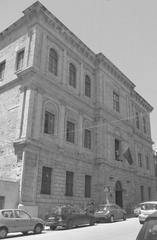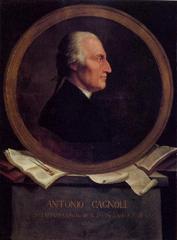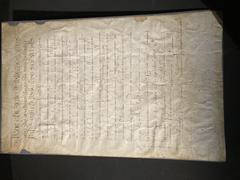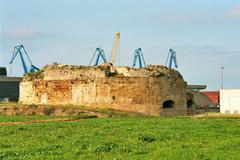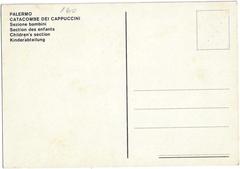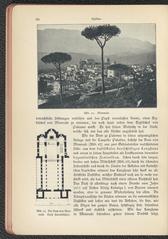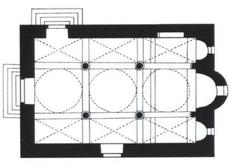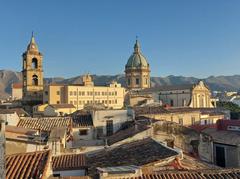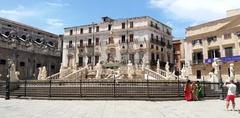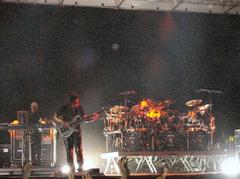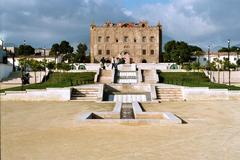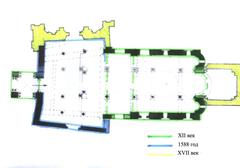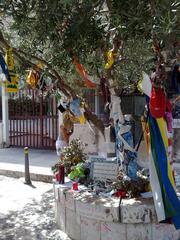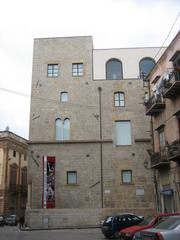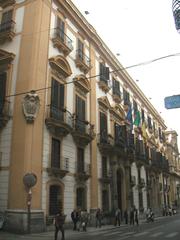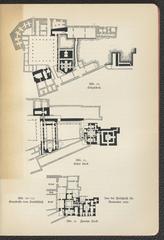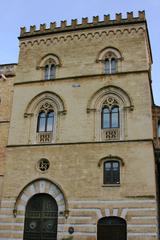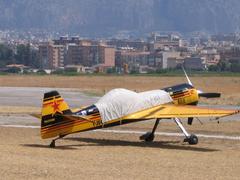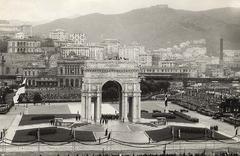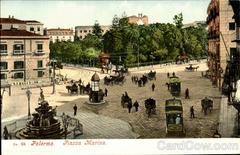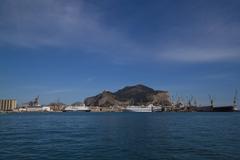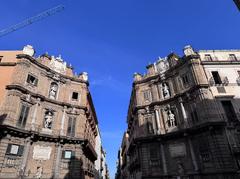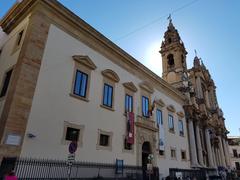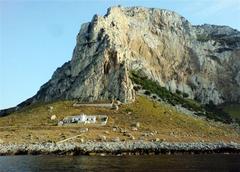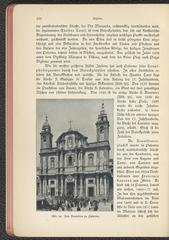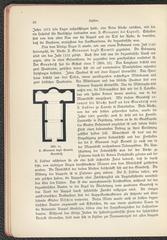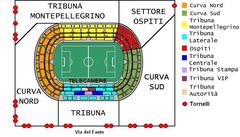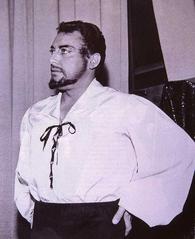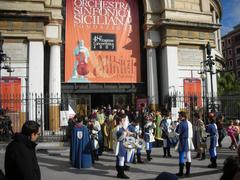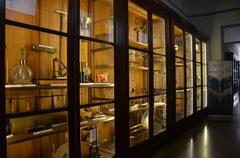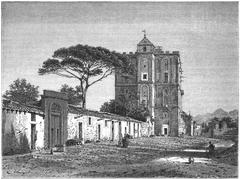Visiting Hours and Tickets for Museo Palazzo Branciforte, Palermo
Date: 31/07/2024
Introduction
Nestled in the heart of Palermo, Sicily, Museo Palazzo Branciforte stands as a beacon of historical and cultural significance. Originally constructed in the 16th century as an aristocratic residence for the Branciforte and Lanza families, this Renaissance-style palace has undergone numerous transformations. From a grand aristocratic residence to a charitable institution known as the Monte di Santa Rosalia, and later a pawn shop, the building’s history is a testament to Palermo’s rich and dynamic heritage. Today, after extensive refurbishment led by renowned architect Gae Aulenti, Palazzo Branciforte serves as a vibrant cultural center housing the Fondazione Sicilia’s extensive collections of archaeological artifacts, coins, stamps, maiolica, and more (Wikipedia). Visitors can explore not only its historical significance but also its modern attractions, such as a local cooking school and restaurant sponsored by Gambero Rosso, making it a must-visit destination in Palermo (Lonely Planet).
Table of Contents
- Explore the Rich History and Modern Attractions of Palazzo Branciforte in Palermo
Explore the Rich History and Modern Attractions of Palazzo Branciforte in Palermo
Introduction
Palazzo Branciforte, one of Palermo’s most distinguished historical sites, has transformed from a grand aristocratic residence to a vibrant cultural center. Whether you’re interested in its storied past or its modern-day attractions, Palazzo Branciforte promises a fascinating experience. This guide will provide you with an overview of its history, current attractions, and essential visitor information.
History of Museo Palazzo Branciforte
Origins and Early History
The origins of Palazzo Branciforte date back to the 16th century when it was constructed as a grand aristocratic residence for the Branciforte and Lanza families. This Renaissance-style palace, located on Via Bara dell’Olivella in the historic center of Palermo, Sicily, was designed to reflect the wealth and status of its noble inhabitants. The palace’s architecture and design were emblematic of the Renaissance period, characterized by symmetry, proportion, and the use of classical elements.
Transition to Monte di Santa Rosalia
In the 18th century, the palace was inherited by the Branciforte di Butera family. However, in 1801, the family ceded the palace to the Senate of Palermo. The Senate repurposed the building into the Monte di Santa Rosalia, a charitable institution aimed at supporting the indigent population of Palermo. This transformation was significant as it marked the palace’s shift from a private aristocratic residence to a public welfare institution. The Monte di Santa Rosalia was funded by a Monte della Pietà per la Pignorazione, essentially a pawn shop establishment, which provided financial support for the charity (Wikipedia).
19th Century Challenges
The 19th century brought significant challenges to Palazzo Branciforte. During the 1848 rebellions, the building suffered extensive damage due to a fire. This period of political upheaval in Sicily saw many structures, including Palazzo Branciforte, affected by the conflict. Despite the damage, the building continued to serve its charitable purpose.
Acquisition by Cassa di Risparmio Siciliana
In 1929, the palace was acquired by the Cassa di Risparmio Siciliana. This acquisition marked another chapter in the building’s history, as it transitioned from a charitable institution to a financial establishment. However, the palace’s troubles were far from over. During World War II, the building sustained further damage from aerial bombardments, reflecting the widespread destruction experienced across Europe during the war (Wikipedia).
Continued Use as a Pawn Shop
Despite the damages and changes in ownership, Palazzo Branciforte continued to function as a pawn shop until the 1980s. This long-standing role as a Monte dei Pegni highlights the building’s enduring connection to financial services and support for the local community. The pawn shop provided a means for individuals to secure short-term loans against personal valuables, a service that was crucial for many during times of economic hardship.
Refurbishment and Modern Use
In 2005, the Fondazione Banco di Sicilia acquired Palazzo Branciforte. This acquisition marked the beginning of a significant refurbishment project aimed at restoring the palace to its former glory while repurposing it for modern use. The renowned Italian architect Gae Aulenti was commissioned to oversee the refurbishment. Aulenti’s vision for the palace included the creation of a modern cultural center that would house a library, auditorium, exhibition halls, and various collections (Lonely Planet).
Fondazione Sicilia and Cultural Significance
Since the completion of the refurbishment in 2012, Palazzo Branciforte has been the home of the Fondazione Sicilia. The foundation uses the palace to display its extensive collections of archaeological artifacts, coins, stamps, tin-glazed pottery (maiolica), sculpture, and frescoes on panel. The main painting collection of the foundation is displayed at Villa Zito, another significant cultural site in Palermo. Additionally, the foundation houses a collection of Sicilian puppets made by the Cuticchio family, along with theatrical scenes, reflecting the rich cultural heritage of Sicily (Wikipedia).
Modern Cultural Center
Today, Palazzo Branciforte stands as one of Palermo’s grandest aristocratic palaces, now transformed into a multi-faceted cultural center. Visitors can explore the Fondazione Sicilia Library, which features a bold contemporary fresco by Ignazio Moncada di Paternò. The Monte di Santa Rosalia has been converted into a spectacular timber-framed exhibition space that houses an important collection of traditional Sicilian pupi (puppets). The ground-floor archaeological collection boasts over 4750 objects, many of which were unearthed at the ruins of Selinunte, an ancient Greek city on the southwestern coast of Sicily (Lonely Planet).
Culinary and Educational Initiatives
In addition to its cultural and historical exhibits, Palazzo Branciforte also hosts a local cooking school and restaurant sponsored by Gambero Rosso, a prominent Italian food and wine magazine. This initiative aims to promote Sicilian cuisine and culinary traditions, offering visitors a unique gastronomic experience. The combination of cultural, historical, and culinary attractions makes Palazzo Branciforte a must-visit destination for tourists in Palermo (Wikipedia).
Visitor Information
Tickets and Visiting Hours
Palazzo Branciforte is open to visitors from Tuesday to Sunday, 9:30 AM to 7:30 PM. Tickets can be purchased at the entrance or online. General admission is €7, while discounted tickets for students and seniors are available for €5. Children under 12 can enter for free. Special guided tours can be arranged in advance.
Travel Tips and Nearby Attractions
Palazzo Branciforte is conveniently located in the historic center of Palermo, making it easily accessible by public transport. Nearby attractions include the Teatro Massimo, the Quattro Canti, and the Palermo Cathedral, all within walking distance. For a comprehensive experience, consider spending a day exploring these historical sites.
Accessibility
The palace is wheelchair accessible, with elevators and ramps available for visitors with mobility issues. Audio guides and informational brochures are available in multiple languages to enhance the visitor experience.
Special Events and Guided Tours
Throughout the year, Palazzo Branciforte hosts a variety of special events, including art exhibitions, cultural performances, and educational workshops. Guided tours are available in several languages and can be booked in advance. These tours provide in-depth insights into the history and significance of the palace’s collections.
Photographic Spots
Photography enthusiasts will find numerous spots within Palazzo Branciforte to capture stunning images. The contemporary fresco by Ignazio Moncada di Paternò, the collection of Sicilian puppets, and the archaeological artifacts offer excellent photo opportunities. Remember to check the palace’s photography policy before your visit.
FAQ
Q: What are the visiting hours for Palazzo Branciforte? A: Palazzo Branciforte is open from Tuesday to Sunday, 9:30 AM to 7:30 PM.
Q: How much do tickets cost? A: General admission is €7, with discounts available for students and seniors at €5. Children under 12 enter for free.
Q: Is Palazzo Branciforte wheelchair accessible? A: Yes, the palace is wheelchair accessible, with elevators and ramps available.
Q: Are guided tours available? A: Yes, guided tours are available in several languages and can be booked in advance.
Q: Can I take photos inside Palazzo Branciforte? A: Yes, photography is allowed in most areas, but please check the palace’s photography policy.
Conclusion
Palazzo Branciforte’s rich history, from its origins as an aristocratic residence to its current role as a cultural center, reflects the dynamic and multifaceted heritage of Palermo. The palace’s transformation over the centuries highlights its resilience and adaptability, making it a symbol of the city’s enduring cultural legacy. Visitors to Palazzo Branciforte can immerse themselves in the history, art, and traditions of Sicily, ensuring a memorable and enriching experience.
Call to Action
Plan your visit to Palazzo Branciforte and discover the rich history and modern attractions it has to offer. Download the Audiala app for a comprehensive guide, check out other related posts, and follow us on social media for more updates.
Summary and Call to Action
Museo Palazzo Branciforte encapsulates the essence of Palermo’s historical and cultural journey. From its origins as a luxurious aristocratic residence to its role as a modern cultural hub, the palace reflects the city’s resilience and adaptability. The meticulous restoration and the incorporation of contemporary elements by architect Gae Aulenti have rejuvenated the palace, making it a symbol of Palermo’s enduring legacy. Visitors can immerse themselves in a rich tapestry of history, art, and Sicilian traditions through the museum’s diverse collections and educational programs. Furthermore, the culinary initiatives and special events hosted at the palace offer a unique and enriching experience, ensuring that every visitor leaves with a deeper appreciation of Palermo’s cultural heritage (Palazzo Branciforte, Italia.it). Whether you are a history enthusiast, a cultural explorer, or a culinary aficionado, Palazzo Branciforte promises an unforgettable journey through time and tradition.
